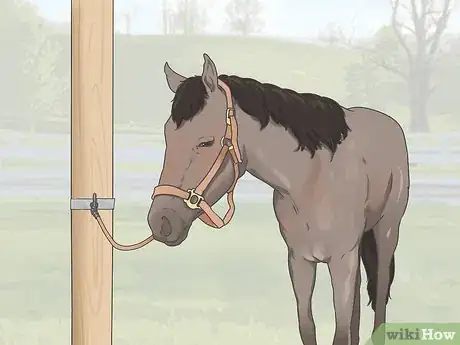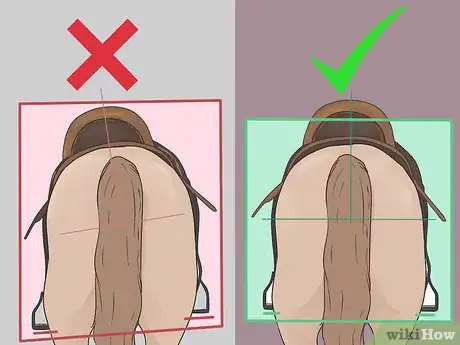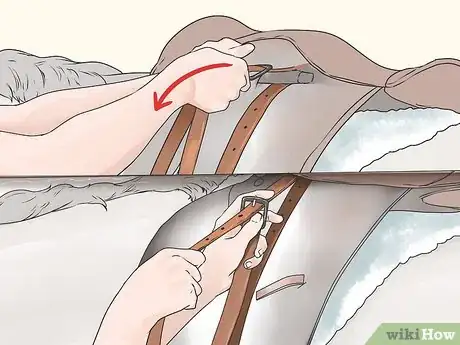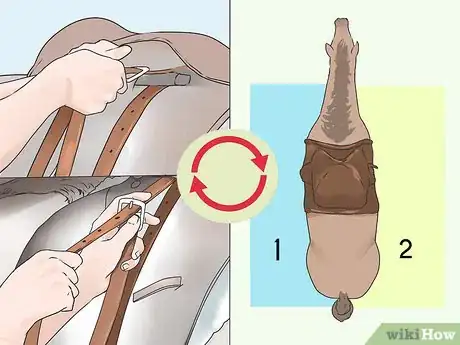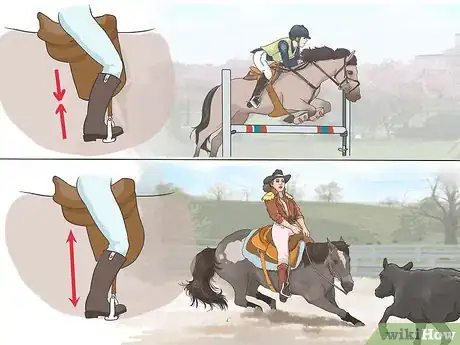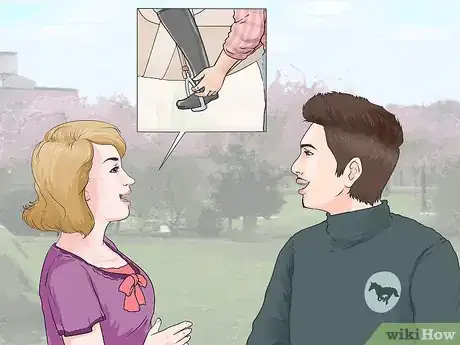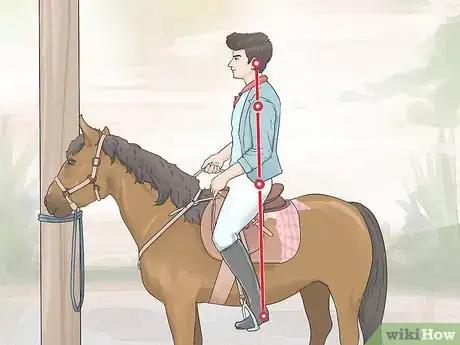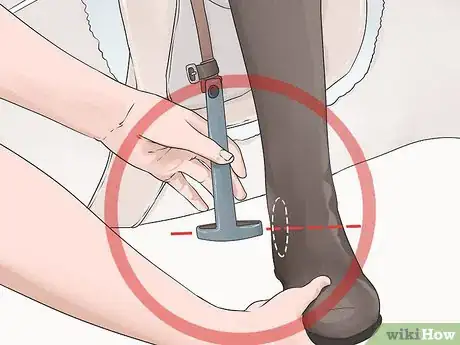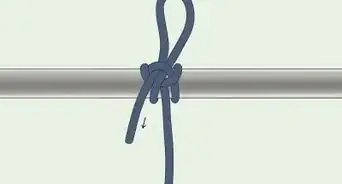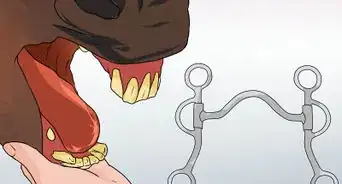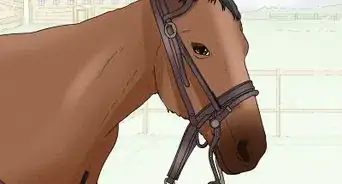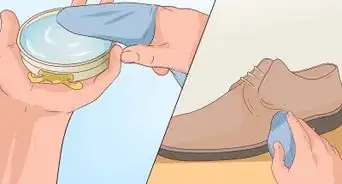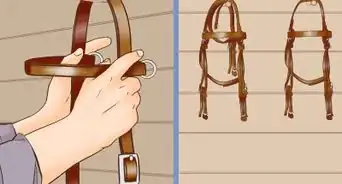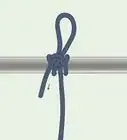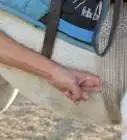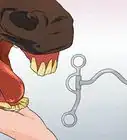This article was co-authored by Ryan Corrigan, LVT, VTS-EVN. Ryan Corrigan is a Licensed Veterinary Technician in California. She received her Bachelor of Science in Veterinary Technology from Purdue University in 2010. She is also a Member of the Academy of Equine Veterinary Nursing Technicians since 2011.
wikiHow marks an article as reader-approved once it receives enough positive feedback. In this case, 87% of readers who voted found the article helpful, earning it our reader-approved status.
This article has been viewed 69,342 times.
In horseback riding, it is essential to get the proper body alignment in order to be safe and comfortable during a ride. If it is too long, your leg will be loose. If it is too short, you will be uncomfortable and unable to use your legs effectively while riding. Unfortunately, stirrup misalignment is fairly common in new riders. There are a number of things that are key for proper stirrup alignment, and among them measuring for proper stirrup length is key. In general, you must first find a good starting stirrup length while still on the ground and then you need to make adjustments once you are on the horse. This will allow you to have proper stirrup length and riding position.[1]
Steps
Measuring Stirrup Length While on the Ground
-
1Secure your horse or pony. Tie the pony or horse to a post, rail, or crossties before beginning your stirrup adjustments. Never leave your horse or pony untied while moving the stirrups up or down.
- Alternatively, can have someone else hold the horse in place while you adjust the stirrups.
-
2Check that the saddle is on correctly. Before measuring for your stirrup length, you need to be sure that the horse's saddle is on correctly. If it is not, the measurements you do will not be correct. Look both parallel to the horse and perpendicular, making sure that the saddle is square and that the stirrups are both the same length.
- If the saddle is not square, adjust the saddle on top of the horse before you start adjusting the stirrups.
Advertisement -
3Measure the stirrup against your arm. Find a starting position for the stirrup in which it is about as long as your arm. This will allow you to hold it out and do more exact measuring. Pull the stirrup iron straight out until it sits just under your armpit, and the leather runs the full length of your arm. If the end of the stirrup iron doesn't reach your armpit when your fingers reach the saddle, then the stirrup is too short. If it droops between your armpit and your fingers, then it is too long.
- While measuring, stand perpendicular to the horse and the stirrups.
- If you have just begun riding, have shorter rather than longer stirrups so that you will have more control.
-
4Adjust the buckle on the stirrup leather. Once you know the correct length, you will need to adjust the length by putting the stirrup buckle into the correct hole on the stirrup leather. Get hold of the buckle at the top of the stirrup leather and adjust the buckle until the stirrup is the correct length.
- Most buckles are tucked up close to the saddle but can be pulled down lower during adjustment. This will make adjustment easier.
-
5Repeat the process on the other side. Loosen the stirrup on the other side so that it is about as long as your arm. Pull the stirrup iron straight out towards your armpit. The length of the stirrup from the connection on the saddle to the bottom of the stirrup iron should be the length of your arm from the armpit to the fingertips.
- Once both are adjusted, look at them both from the front of the horse. They should be the same length.
-
6Keep the type of riding you will be doing in mind. The length of stirrups you want may also differ slightly depending on what type of riding you are going to do. For example, If you are jumping or roping, you need a short stirrup length to sit higher in the saddle.[2]
- If you are doing dressage, cutting, or saddle seat riding, your stirrup length should be slightly longer because the rider is sitting back in the saddle and using a lot of leg to control the horse.
Measuring Stirrup Length While on a Horse
-
1Ask someone to help you. In order to really accurately measure your stirrup length you may want to have a helper. Having someone else to help you will allow you to get in the saddle and assess where the right length should be.[3]
- This person can also help hold the horse still while you are making adjustments and they can help you get up into the saddle if you need help.
- If you are a beginner, have a teacher or a more experienced rider help you choose the right saddle and stirrup length. They should belong to the same discipline of riding as you do.
-
2Align yourself in the saddle. Once you get up into the saddle, make sure your ears, shoulders, hips, and heels are all in straight alignment. Making sure that you are in alignment will help to assure that you get the right stirrup measurement.[4]
- Put your feet into the stirrups while you are assessing your alignment. This help you get a general feeling for whether they the right length or not.
-
3Assess the stirrup length when your feet are out of the stirrups. Take your feet out of the stirrups. Have your friend make sure that the bottom of the stirrup is level with your ankle bone when your feet are out of the stirrups.
- This may be hard to see because of riding boots, so the friend may need to feel with their fingers to know where your ankle bone lies.
- If you are doing a type of riding that requires shorter or longer stirrups, take that into consideration here. For example, if you want shorter stirrups because you are going to do some jumping, make sure that the stirrups hit your leg above the ankle bone. If you want longer stirrups for dressage or cutting, the stirrup should line up below the ankle bone.
-
4Assess your position when your feet are in the stirrups. With your feet in the stirrups once again, you should assess whether the ball of your foot is resting on the iron. If it is, your heels should be pointing directly downward and your toes pointing forward.
- Once again, your helper may be in the best position to judge whether this is the case.
- If you don't have a helper, you can stand up in the stirrups and judge the amount of space you have between the saddle and your seat. There should be a space about the size of a fist, but this is a relatively inexact measurement.
-
5Check the stirrup length while you are riding. Take a ride around your corral or ring and ask your friend to check your alignment. Have them look at the angle of your leg when they are perpendicular to you. Also, the angle of the upper leg should equal the angle of the horse's shoulder.[5]
- There should be an equal angle between the thigh and the knee and the knee and the lower leg. If not, the stirrup is usually too long, creating a straighter angle in the lower leg.
Warnings
- Make sure the stirrup buckle gets put in the hole securely. Otherwise, it might release the stirrup while you are riding.⧼thumbs_response⧽
References
- ↑ http://www.horsesaddleshop.com/correct-stirrup-length.html#.WMoLfRA0glE
- ↑ http://www.horsechannel.com/english-horse-training/stirrup-length-for-flatwork-and-jumping.aspx
- ↑ http://www.horsesaddleshop.com/correct-stirrup-length.html#.WMoLfRA0glE
- ↑ http://www.equine-world.co.uk/riding_horses/rider_position.asp
- ↑ http://www.equine-world.co.uk/riding_horses/rider_position.asp
- ↑ http://www.horsesaddleshop.com/correct-stirrup-length.html#.WMoLfRA0glE
